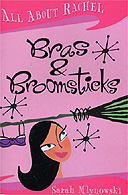
I was standing in a bookshop recently, looking for a present for my daughter so that I'd feel less selfish about the stack of novels that I was buying for myself. I scanned the shelves of books about bears who can talk and peaches which can grow enormous, but my gaze kept being drawn to books that I didn't expect to see in the children's section. You know what the covers of chick lit books look like: all pink and silver with scrawly writing and smiling, girly faces. There are a surprising number of books that look like that now in the children's sections of bookshops. This is chick lit for the under-12s: chicklet lit, you could call it.
Chicklet lit is a boom area. It starts with tales for teeny girls, and in a way these are just traditional stories about fairies and ballerinas, but they have a twist: the heroines have to keep being reminded to put on pretty clothes and do their hair nicely, and the story has to end with a lovely party. Once I started reading them, I realised I'd never met such boring fairies. Even Tinkerbell was stroppy, while E Nesbit's sand fairy was positively grumpy and unpredictable.
But these fairies just twitter about how pretty their knickers are, how nice their perfume is, and what fun they are going to have at the party. When human girls get into fairyland, it's all about makeovers rather than magic. "Evie took off her pyjamas ... then she put on the blue sparkly dress and matching knickers - which both fitted her perfectly now that she was fairy-sized herself. There was a mirror on one wall and when she went to look at herself she couldn't help smiling - she looked so pretty. Now all she had to do was fix her hair."
Having plodded through a few of these dinky trips to fairyland, courtesy of Gwyneth Rees, Penny Dann and Daisy Meadows, I felt as if I'd been eating nothing but candyfloss all morning, and I decided to graduate to the books aimed at slightly older, but still pre-pubescent girls. These books follow in the wake of the hugely successful chicklet novel The Princess Diaries, which does itself have a certain brio. But after a while I realised that if I heard any more from Helen Bailey about Topaz's disasters on the red carpet, or read any more about clear skin spells in Sarah Mlynowski's horribly named Bras and Broomsticks, I would choke on a surfeit of saccharine.
For sure, these books aren't all bad; in fact, some fine writers for young girls are now being packaged in pink and silver when they deal with much darker and deeper subjects than the covers suggest. But the sugary core of this genre relies on an unchanging tone of tinkly enthusiasm, and emphasises a single narrow theme: that young girls are naturally obsessed only with their appearance and social success from an incredibly early age.
It is strangely unsettling to see how very constrained these books' view of their readership is, just at a time when you might be thinking that young girls are stepping out with more freedom. The other weirdly unsettling thing about them is how they show that people clearly believe boys and girls will gravitate to absolutely different books from such a very early age; and that writers and publishers are keen to encourage them to go in these different directions.
I know it was like that in the past, and that if you mention Noel Streatfeild or Anne of Green Gables to most grown men they won't have a clue what you are talking about, but it is odd to see this generation of writers, in a time of growing equality, so keen to keep boys and girls looking at separate bookshelves.
The constricting effect this has is just as strong for boys as for girls. Because, while I think most girls would read these books and still feel free to lap up Horrid Henry in between, few boys would be seen dead reading about Jasmine the Present Fairy.
That conditioning about suitable books for boys and for girls helps one to understand why it is that grown men are still reluctant to read books by women. A fascinating survey report last weekend, by Lisa Jardine and Annie Watkins for the 10th anniversary of the Orange prize, showed that while women happily read books by both sexes, men were much more likely only to read novels by men: "Consequently, fiction by women remains 'special interest', while fiction by men," it reports, "still sets the standard for quality, narrative and style."
That's true, and the aggressive marketing of books for young girls as this dinky, tweety area where boys are completely unwelcome will only help to keep up these barriers between girls' books and boys' books for the next generation.
While few people would give a hoot if boys aren't reading about Jasmine and Topaz, it matters a whole lot more when these boys grow up. Then an abiding suspicion will haunt them that fiction by women - not just chick lit, but also the serious, subtle, exciting fiction that women are writing - still somehow belongs in a separate, decorative genre rather than on their bookshelves. And that means that too many men will remain cut off from some of the best explorations of the human heart that contemporary culture can offer.

